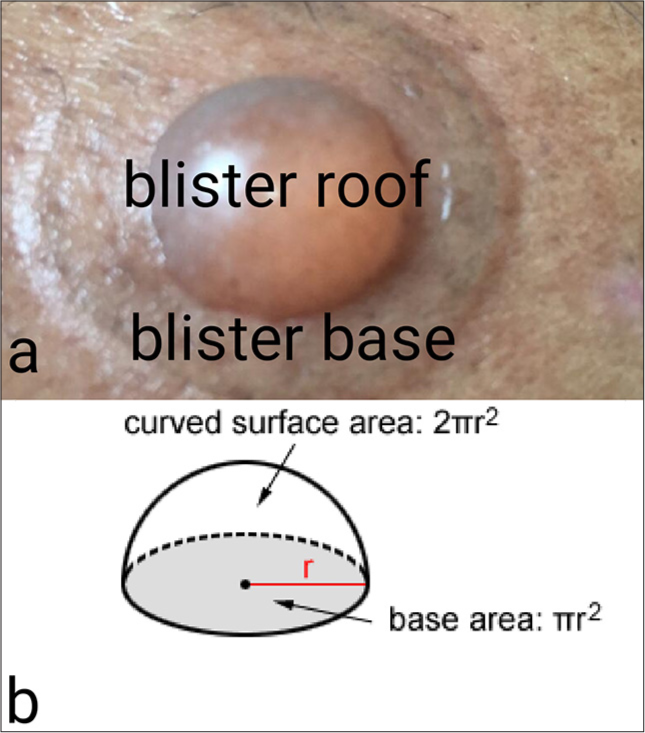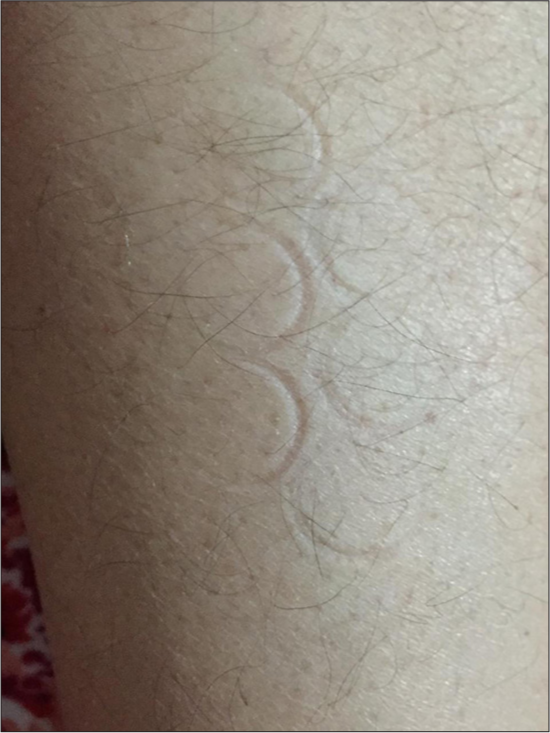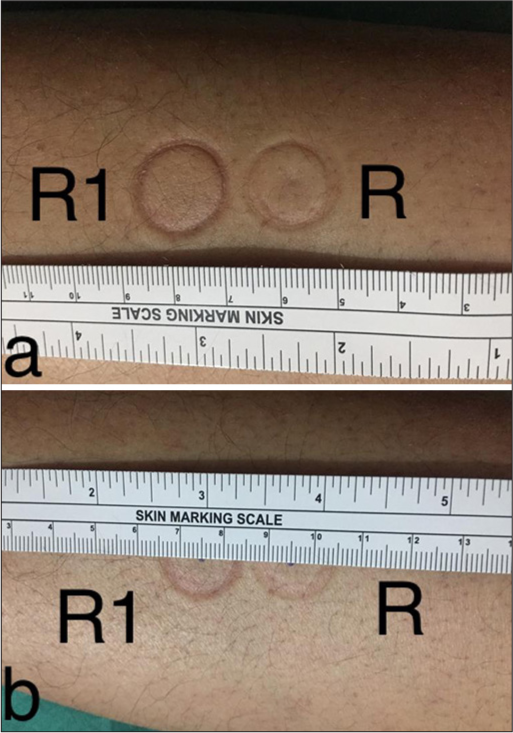Translate this page into:
An insight: Geometrical relationship between suction device size and blister and its clinical importance

*Corresponding author: Muhammed Mukhtar, Department of Dermatology, Mukhtar Skin Centre, Katihar, Bihar, India. drmmukhtar20@gmail.com
-
Received: ,
Accepted: ,
How to cite this article: Mukhtar M. An insight: Geometrical relationship between suction device size and blister and its clinical importance. CosmoDerma. 2025;5:10. doi: 10.25259/CSDM_168_2024
PROBLEM
We routinely use suction equipment to produce suction blisters.[1,2] However, we have no idea how the suction cup’s size relates to the blister. We try to mathematically prove the relationship between the radius and area of the suction site and the blister/graft surface.
SOLUTION
Geometry explains that the area of a circular plane is A = πr2, while the area of a hemispherical plane is A = 2 πr2. Here, we suppose that the radius of the suction cup (circle) and its blister (hemisphere) is R. Thus, the area of the skin sucked by the cup is A = πR2 while the area of the blister is A = 2 πR2 [Figure 1a and b]. As a result, the area of the fully developed blister roof is twice as large as the area suctioned by the device. However, the radius of the completely spread blister graft is unknown. Assume the radius of the graft is R1, and the radius of the skin suctioned is R.

- (a and b) Areas of circle (base) and hemisphere structure like blister of radius r and its relation. π: Pi (=3.14), r: Radius of circle/rim of device/blister and of hemisphere/blister.

- Measurement of skin with rim of a suction device used.
CALCULATION
Hence, we can write an equation.
The area of a circle divided by a hemisphere equals the area of suctioned skin divided by the area of the blister roof.
The area of circle/area of hemisphere = area of suctioned skin/area of blister roof. Hence, = (after crossing πr2 on the left and π on the right side). Hence, R12 = 2 R2 (on cross multiplication).
Thus, R1 = 1.4142 R (on doing square root on both sides).
π: Pi (=3.14), r: Radius of circle and hemisphere, R: Radius of donor before suction, R1: Radius of donor site after suction.
Hence, the radius of the harvested graft of a well-developed blister is to be 1.41 times of the suctioned skin site and its area is twice of the donor site.
CLINICAL IMPORTANCE
We can determine that the graft’s area is twice that of the donor site and its radius is 41% more than that of the donor site.
We can estimate how many blister grafts will be needed after measuring the donor area with the device used [Figure 2].
The graft’s increased size is the result of the epidermis inflating and additional skin being drawn from the edge.
-
Before and a bit after the 5-min suction operation, the skin surface can display difference in the impression of the same device and it’s radii [Figure 3a and b].
 Figure 3:
Figure 3:- (a and b) The difference in impressions of the same device rim on right side of radius (R) and on left side of radius (R1) before and after 5 min suction on donor sites.
To prevent damage to the sucking skin of the margin and protect the blister, the device’s rim should be perfectly leveled and smoothened with a pumice stone and gently and equally heating the rim of device on a flame vertically from a distance, not horizontally or in inclined plane.
The suction will be less effective on loose and uneven surfaces because a larger suction area (P=F/A, where P represents pressure, F force, and A area) results in less effective pressure. A small, smooth, airtight suction syringe or cup with a small radius height should be applied to a firm hard or well stretched least movable, flat skin area for a rapid suctioning action.
To enhance the size of the graft, harvest blisters by detaching their periphery rather than cutting with mosquito scissors.
This article aims to correlate the radius of the device and its graft. The skin elasticity, suction site, patient age, amount of negative pressure, skin temperature, intradermal saline injection, corticosteroid atrophy, PUVA therapy at the site, uniformity of suction force, and device shape all have an impact on blister formation. In addition to these factors, consider the smoothness of the device’s inner border and rim, as well as the thickness, airtightness, firmness, and flatness of the skin surface, to ensure a well-developed suction blister.
Ethical approval
Institutional Review Board approval is not required.
Declaration of patient consent
Patient’s consent is not required, as there are no patients in this study.
Conflicts of interest
There are no conflicts of interest.
Use of artificial intelligence (AI)-assisted technology for manuscript preparation
The authors confirm that there was no use of artificial intelligence (AI)-assisted technology for assisting in the writing or editing of the manuscript and no images were manipulated using AI.
Financial support and sponsorship
Nil.
References
- Disposable syringe cup for 3-way cannula-syringe suction. J Am Acad Dermatol. 2022;86:e3-4.
- [CrossRef] [PubMed] [Google Scholar]
- Suction pearl: Standardization of the suction heights of suction syringes. J Skin Stem Cell. 2021;8:e106099.
- [CrossRef] [Google Scholar]





